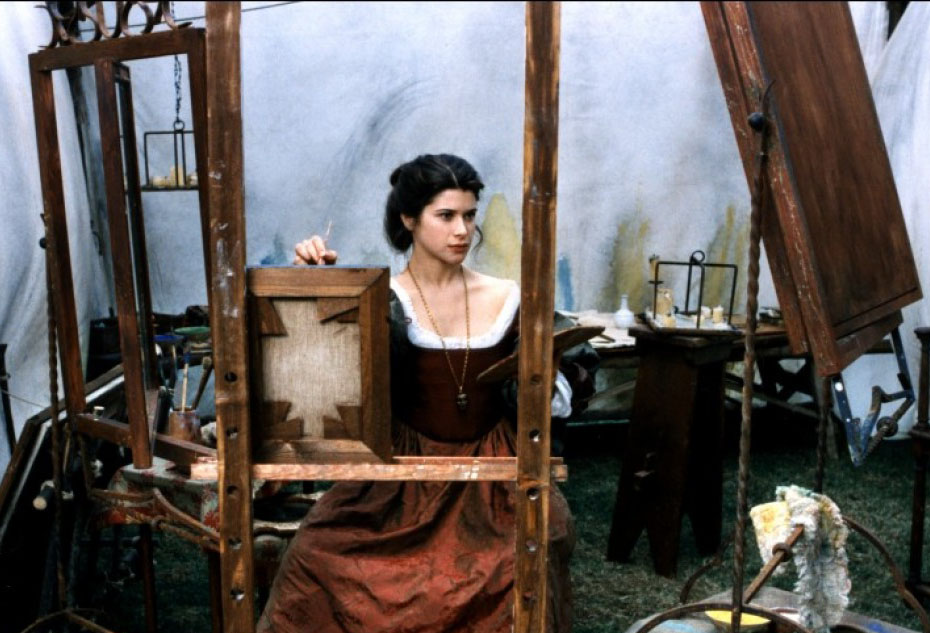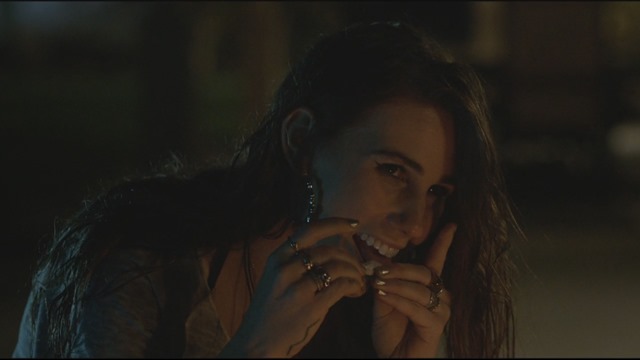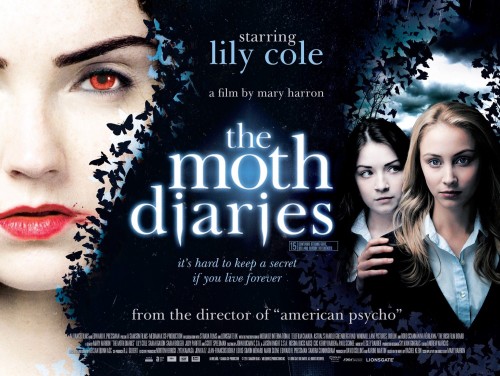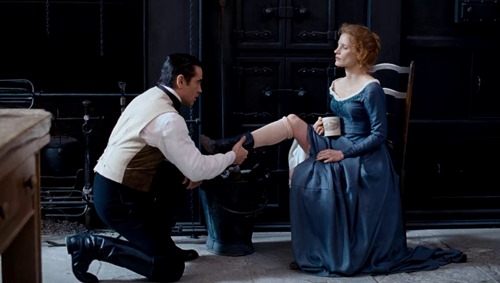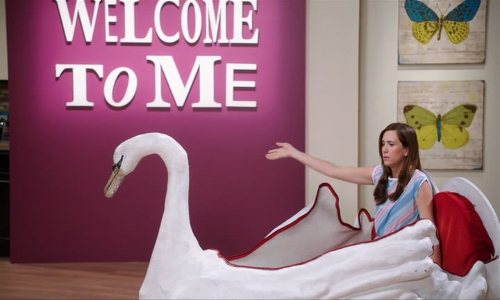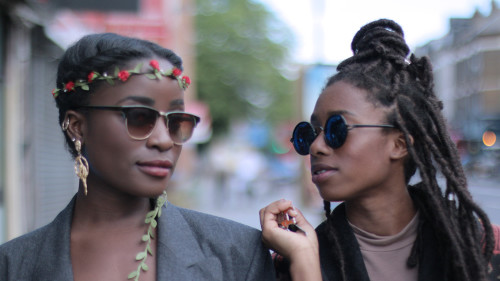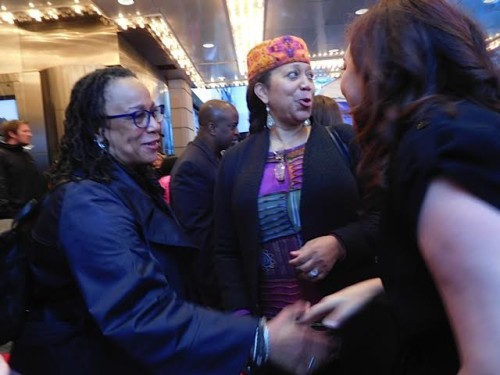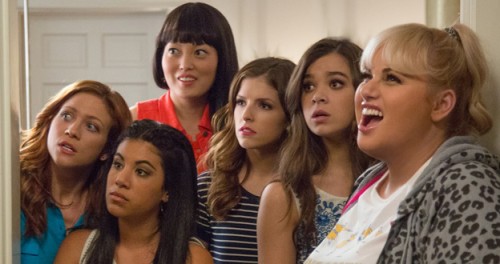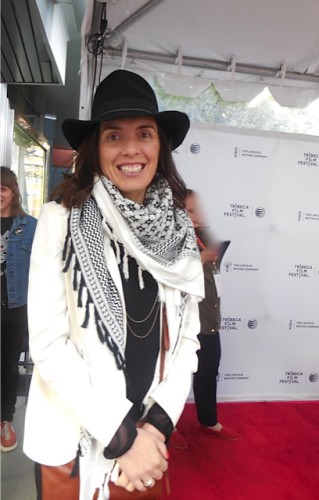Written by Brigit McCone.
[Trigger warning: discussion of rape]
Is it possible to admire a woman’s art while denying its meaning? Certainly, a feminist viewer wants to admire 1997’s Artemisia, a ravishingly beautiful film about a young girl seizing control of her talent and sexuality in the face of a sexist society, filmed by a female director, Agnès Merlet. It tells the story of the first woman to become an official member of Florence’s Academy of Art and Design, the most famous female artist of the Renaissance, Artemisia Gentileschi. Merlet’s Artemisia is a director before her time in the seventeenth century. She oversees the setting up of her studio with minute detail and assertive power, frames her paintings like movie shots, orders men to strip and model for her, and poses their naked bodies with intense interest. Even as a girl in the repressive environment of a convent school, Gentileschi is studying and sketching her naked body with a mirror, with a heroic immunity to social pressures. She has a lively sexual curiosity, spying on a couple having sex on the beach before fitting herself into the imprint their bodies have made in the sand, and watching the older painter Agostino Tassi’s orgies with fascination. It is she who pursues Tassi to be her teacher, who strips and poses him as a model, who dictates the terms of their relationship. The film begins with a close-up of Artemisia’s rolling eyeball and it is shaped by her gaze. To see the beautiful, youthful Valentina Cervi cast as the artist instead of the muse, stripping and studying men for her own pleasure rather than being stripped, should mark Artemisia as a refreshing feminist delight. If only Artemisia herself were a fictional character.
But Artemisia is a historical figure, and transcripts from her grueling, seven-month-long rape trial have survived and are the major source for the film. It is a historical fact that Artemisia Gentileschi accused Agostino Tassi of breaking into her bedchamber and raping her. Merlet’s film follows the rough outline of what the real Gentileschi described, but reimagines it as clumsy seduction. Artemisia’s refusals are a murmured reluctance, not strong or fearful denials. She returns kisses and submits, before gasping in pain and pushing Tassi away, as he mumbles in apologetic confusion at the misunderstanding over her virginity. Not that virginity is a particularly great concern for the unbelievably socially immune Artemisia. The whole event is miscommunication more than violation. Later, the youthful Artemisia will take the controlling and guiding role in their love-making, posing the submissive and adoring Tassi for her signature portrait of “Judith Beheading Holofernes,” straddling him in seduction rather than attempted murder. For the masterful Tassi, who is accustomed to ordering around his naked female models like pieces of meat, to find himself awed and overcome by the strength of Artemisia’s personality is an interesting role reversal. When her father, the painter Orazio Gentileschi, discovers their affair, he tries to force Tassi to marry Artemisia and initiates the rape trial, despite Artemisia telling him that Tassi didn’t rape her but “gave me pleasure.”
Again, one can see a feminist message here, criticizing a society that refuses to acknowledge a woman’s sexual agency or pleasure, yet Merlet is not only twisting the facts but ignoring them, in her need to reinterpret rape testimony as romance. Her Artemisia never accuses Tassi of rape. The fingers of her artist’s hands are bound with chords and torturously squeezed, to force her to confess that she was raped, while Tassi watches in loving agony and confesses himself, merely to spare her pain. In the harsh world of historical fact, Gentileschi was indeed tortured, but it was to force her to withdraw her detailed accusations. Her society pressured women, not to make false accusations but to deny rape. Tassi, meanwhile, defended himself by alleging that Gentileschi was promiscuous and “an insatiable whore.” Whatever their relationship was, it was hardly an epic romance. Why, then, does Merlet, or her intended audience, feel such a need to reimagine it as one? Art historian Mary Garrard and feminist journalist/activist Gloria Steinem protested the film’s inaccuracies at the time of its release. But watching the film, I was struck by more than historical untruth.
I thought about the transformations Merlet had performed on the historical sources: she silenced Artemisia’s testimony, by denying it was ever given; she painstakingly reimagined the circumstances described in the rape transcripts, in such a way that they could have been romantic misunderstanding or clumsy seduction; finally, she reversed an entire society’s values, to imagine a woman pressured by law enforcement to make false accusations, rather than punished for daring to allege rape. The impulse to erase a woman’s testimony, to deny her agency and perception of the crime, while denying society’s victim blaming and bias against survivors of rape — this is the basis of what feminism describes as rape culture. Yet here it is practiced not by a misogynist man, nor by a loyal friend of the alleged rapist, but by a female director aiming to create “emphatically a feminist film.” Why does Merlet feel such a strong compulsion to defend a man who has been dead for over 400 years? Or, is it the image of a vulnerable and exploited Artemisia that she cannot tolerate? What do her rewrites tell us about the mental roots of rape culture?
In an interview by Merlet with the UK’s Independent, two possible reasons are given for Artemisia‘s portrayal. Merlet wanted Artemisia to represent “a more modern kind of feminism, fighting alongside men, not against them,” and she claims that the evidence of the trial can be read in many ways, because there is a “mass of contradictory evidence.” These suggestions need to be considered in more detail. Firstly, what is the contradictory evidence? Perhaps Merlet refers to Artemisia’s testimony that, following her painful rape, she continued to have sex with, and even love, Tassi because he promised her marriage. Regarding this as “contradictory evidence” shows an immaturity in our culture’s understanding of rape, that it must always be the isolated act of a monster, rather than a violation that can take place within a complex relationship. More than that, though, it is a denial of historical context. Deuteronomy 22:28, which claims that a man who rapes a virgin “must marry the girl, for he has violated her,” would have been generally accepted in Gentileschi’s time. To admit that Artemisia could be terrified by the thought of becoming a “fallen” or ruined woman, and could rely on Tassi’s promise to marry her as her only salvation, is to see her as an uncomfortably vulnerable human rather than Merlet’s dominant superheroine. It was during this period, before the trial (not afterwards, as Merlet’s film suggests), that Gentileschi painted her famous portrait of “Susanna and the Elders,” depicting Susanna’s naked body contorted in horror and writhing away from the staring, whispering judgments of the elders looming over her. It is a powerful portrait of female vulnerability under patriarchal scrutiny, but that is precisely the vulnerability that Merlet does not allow Artemisia to feel. So, we return to the question that opened this post: is it possible to admire a woman’s art while denying its meaning?
Artemisia Gentileschi’s “Judith Beheading Holofernes,” which she painted directly after her humiliating rape trial, is one of the most violent expressions of female rage in art. In contrast to the timid Judith that Caravaggio portrayed, Gentileschi’s women are filled with strength, solidarity and resolution, dominating Holofernes (whose face resembles Agostino Tassi’s) as the male elders had dominated Susanna. Merlet actually cites the power of this painting, and her shock at its female authorship, as the trigger that began her fascination with Gentileschi. Yet she strives to tame the image, presenting it as a loving collaboration between Artemisia and Tassi. By such painstaking reimagining, Merlet reveals the key feature of the 1990s’ “more modern kind of feminism” (or “girl power”): not its willingness to “fight alongside men” (and why should one rapist be representative of “men”?), but its discomfort with female anger and vulnerability. Like Merlet’s film, “girl power” celebrates the positive sexual freedom of women to desire and seduce, but not their negative sexual freedom to refuse and define boundaries; their positive freedom to take charge, not their negative freedom to protest poor treatment. In that, it resembles the freedoms promised to women by the “free love” culture of the 1960s, whose abuses and exploitations prompted second-wave feminism.
Artemisia’s art is certainly celebrated by Merlet’s film through luscious costumes and Caravaggesque lighting, but without its meaning, the art seems hollow and disconnected from the painter herself. When we see Tassi’s image in the real Artemisia Gentileschi’s paintings, as the sleeping man whose head is about to be chiseled open by a smiling woman in “Jael and Sisera,” as the leering satyr in “Corisca and the Satyr,” and in numerous variations on the Judith theme, are we to ignore the repeated violence, to allow it to communicate nothing about the feelings and intentions of the woman behind the brush? Women threatened by voyeurs, like Corisca, Susanna and Bathsheba; women escaping male clutches through heroic suicide, like Cleopatra and Lucretia; women murdering men, like Judith and Sisera — these are the figures that populate the paintings of Artemisia Gentileschi. To deny her rage and vulnerability is to deny the passion and power of her art. Agnès Merlet’s film Artemisia is a beautiful celebration of the positive freedoms of women, that forms a kind of feminist ideal. But without the willingness to explore suffering, or to express anger, it is only half-alive, and a disservice to the full-blooded achievement of Artemisia Gentileschi.
Brigit McCone is still mad she wasn’t taught more about Artemisia in art class. She writes and directs short films and radio dramas. Her hobbies include doodling and getting lost in Vieira da Silva paintings.
